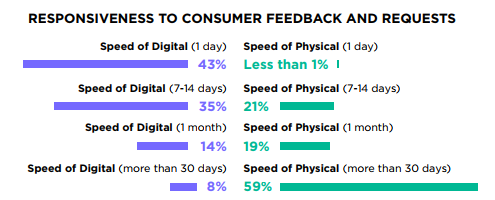 Gathering and analyzing data is only part of marketers’ challenge. Additional hurdles include acting on the data and integrating customer input into business decisions. Consumers want brands to respond swiftly to their issues, needs, requests and suggestions. Only 16 percent of marketers feel their organizations are extremely responsive to the consumer, a CMO Council survey reveals. Their organizations may be slow to make changes to products, packaging, services and experiences based on consumer requests and feedback.
Gathering and analyzing data is only part of marketers’ challenge. Additional hurdles include acting on the data and integrating customer input into business decisions. Consumers want brands to respond swiftly to their issues, needs, requests and suggestions. Only 16 percent of marketers feel their organizations are extremely responsive to the consumer, a CMO Council survey reveals. Their organizations may be slow to make changes to products, packaging, services and experiences based on consumer requests and feedback.
Marketers cite complex business operations, insufficient budgets, and business department silos as major obstacles, according to the CMO Council study, The Responsiveness Requirement: Meeting the Consumer When and Where It Matters to Drive Growth, conducted with Danaher Corporation’s Product Identification Platform.

Image source: CMO Council
On average, marketers feel they are able to respond or react to consumer feedback, requests, suggestions or complaints specific to marketing campaigns in less than two weeks. Digital marketers can more easily alter their campaigns faster than counterparts in the physical realm. Creating new product packaging and placing new packing on store shelves, for instance, is more time consuming. Yet customers have grown used to the speed of digital commerce. Amazon has set the benchmark for expectations.
Recommendations for Agile Marketing
The CMO research recommends:
Start strategic conversations internally to bring product packaging and physical touches like point of purchase (POP) displays and promotions into the customer experience dialogue. That entails more than printing and packaging. It must be discussed as a critical touch in a multi-touch, connected experience.
Set expectations that procurement must act as a strategic partner and not just a cost-cutter. Together, marketing and procurement must identify vendors that can meet responsiveness goals, not just budgetary ones.
Demand transparency. Marketers need to develop supply chain relationships that provide continuous data streams with the intentional goal of total transparency across the supply chain to track everything from creative iteration and collaboration to works in-progress.
Corral all the content makers. Some companies align all brand content development under one creative/marketing leader, whose team consists of subject matter experts for different types of digital and physical channels, such as TV, video, digital, social, packaging and in-store events.
Simplify the entire value chain. The flow of value through the marketing supply chain is long and complex. The more automation, the quicker and more cost-efficiently a company will deliver new products, marketing campaigns and packaging changes to market.
Broaden the meaning of omnichannel to including everything from social posts to product packaging. Combine physical and digital departments. The consumer views a company as one brand — not a physical brand and a digital one.
Omnichannel Marketing: Beyond Multi-Channels
Omnichannel sales and marketing provides customers a seamless shopping experience as they shop online, by phone or in brick-and-mortar stores. It provides greater integration than multi-channel marketing, explains marketing expert Aaron Agius for HubSpot.
“You can have amazing mobile marketing, engaging social media campaigns, and a well-designed website. But if they don’t work together, it’s not omnichannel,” Agius writes. “Every company must develop its own unique omnichannel infrastructure, and you’ll need to work closely with several departments in your company to develop this strong strategy.”
For examples of major brands providing first-class omnichannel customer experiences examine Disney, Virgin Atlantic, Bank of America and REI, he says.
Bottom Line: Brands must react quickly to customer input in order to swiftly alter their sales and marketing strategies. It’s essential for marketers to work closely with other departments to streamline business processes, break down barriers between digital and physical sales and marketing, and create a seamless shopping experience.
William J. Comcowich founded and served as CEO of CyberAlert LLC, the predecessor of Glean.info. He is currently serving as Interim CEO and member of the Board of Directors. Glean.info provides customized media monitoring, media measurement and analytics solutions across all types of traditional and social media.




